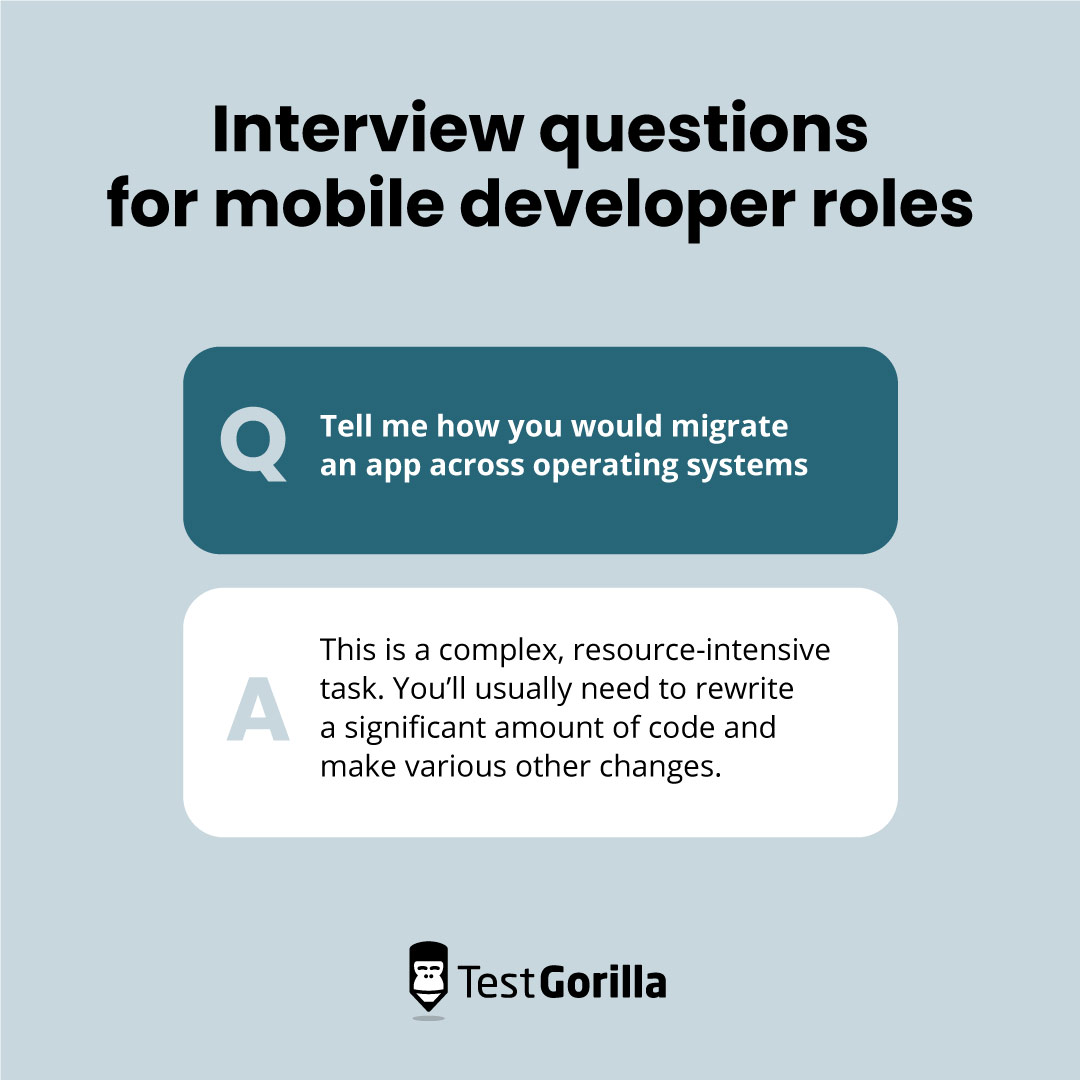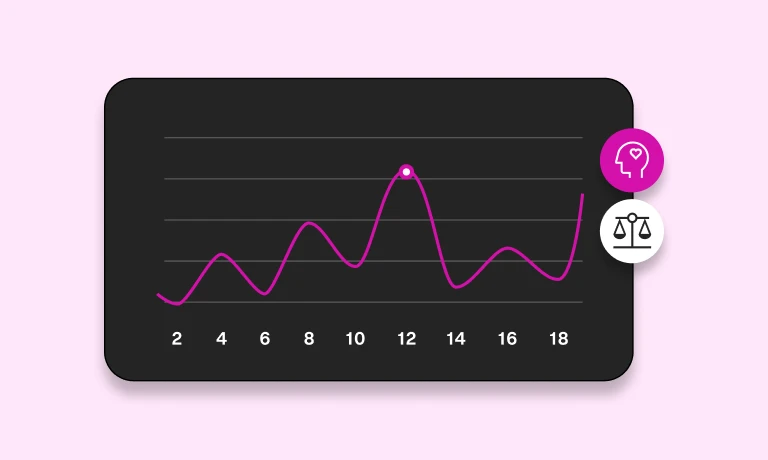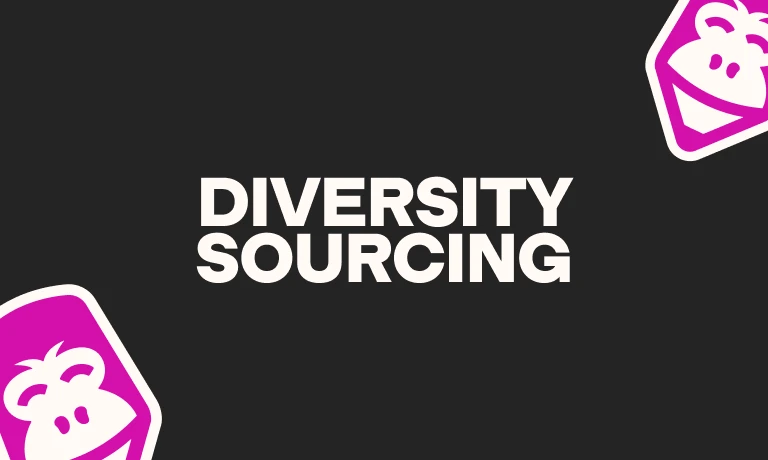10 mobile developer interview questions and answers
Asking the right questions in your mobile developer interviews is critical to identifying top talent so you can hire the best people for your company. They can help you learn more about each candidate’s capabilities, personality traits, and experience – reducing the risk of hiring an app developer who’s unsuitable for your open role.
When mis-hires happen, you face increased recruitment and training costs, an inefficient team, and a significant impact on your bottom line.
But coming up with the right questions can be tricky. Below, we’ve listed 10 mobile developer interview questions – alongside example answers – that you can use as part of your interview process.
How to assess a candidate’s mobile development skills
Custom interview questions are a great way to evaluate candidates’ mobile development skills, but you shouldn’t use them as your only tool for measuring individuals’ suitability for your open positions.
For maximum effectiveness, combine your interview questions with role-specific mobile developer tests to create custom pre-employment assessments for potential candidates. This will give you a well-rounded view of your candidates and help you make better, more data-driven hiring decisions.
TestGorilla is a powerful candidate testing platform that lets you do just this. You can mix and match up to five of our tests – from a library of more than 300 – to create bespoke assessments that measure individuals’ skills, behavioral traits, cognitive abilities, and more.
Let’s say, for example, that you’re hiring an Android mobile application developer to fill an opening in your company. You could combine these tests for a comprehensive assessment:
The Clean Code test
The Problem-Solving test
A few role-specific Android developer tests – such as the JavaScript (Coding): Entry-Level Algorithms test, the Algorithms for Software Engineering test, or the Android Development test
A personality test like DISC or Big 5 (OCEAN)
You could take a similar approach when hiring an iOS mobile developer by combining TestGorilla’s Clean Code test with a handful of iOS developer tests, a motivation or critical thinking test, and a personality test.
If you use Swift development, you can throw in some tricky Swift developer interview questions that challenge the candidate's in-depth language knowledge.
Depending on your needs, you could even use TestGorilla’s catalog of industrial mobile developer tests to create your assessments.
With TestGorilla, you can also add custom questions – like the mobile developer interview questions we discuss below – to any assessment.
Once you’ve created your assessment, you can send it directly to candidates or share it via a link. After they’ve completed it, you can rank results within the TestGorilla app based on both skills tests and your custom questions.
When implemented correctly, this approach can help you identify skilled talent efficiently and with minimal room for error or unconscious bias.
10 interview questions and answers for mobile developer roles
Here, we look at 10 mobile developer interview questions you can ask your candidates, each with an example response so you know what to look for.
1. What are the differences between iOS and Android app development?
Example answer: Several key differences exist between iOS and Android app development, including in the main programming languages.
iOS developers mainly rely on Swift and Objective-C for app development. Most Android developers use Kotlin, and Java remains a popular option, too.
Similarly, the integrated development environment (IDE) for iOS (Xcode) and Android (Android Studio) development is different. Both have clear design guidelines that specify development best practices.
Some of the other points of difference between iOS and Android app development include monetization methods, app distribution channels, and the greater variability in screen sizes of Android devices.
2. Tell me how you would migrate an app across operating systems
Example answer: Migrating a mobile app from one operating system to another (iOS to Android, or vice versa) is a complex, resource-intensive task. You’ll usually need to rewrite a significant amount of code and make various other changes.
Here’s a step-by-step overview of what’s involved.
Assessment and planning, which includes identifying any components that can be reused and those that need to be rewritten.
Codebase conversion, which involves rewriting the necessary code in the appropriate language for your platform. This is usually Objective-C or Swift for iOS 3.
Data migration and conversion between the different versions of your app to ensure your databases remain accurate.
Testing and deployment. First, test your migrated app to identify and eliminate as many bugs as possible. When you’re happy with it, you can deploy it through an app store like the Google Play Store or the Apple App Store.
3. What is a software development methodology? Provide two examples
Example answer: A software development methodology, or a software development framework, is a structured approach to app development. Various methodologies help teams and organizations plan, execute, and deliver software projects as efficiently as possible.
Here are two examples of popular methodologies.
The Waterfall Model. This model follows a linear and sequential development approach, completing each phase in sequence. In an app development sense, these phases could include gathering project requirements, design, implementation, testing, deployment, and maintenance.
Agile Methodology. Agile frameworks are development methodologies that focus on collaboration, adaptability, and customer feedback. The software is delivered frequently, in small, working implements, to speed up the development process.
Different methodologies are best suited to different types of projects. The Waterfall Model, for example, is great for projects with well-defined, stable requirements. On the other hand, Agile Methodologies are best for projects with evolving requirements, dynamic business environments, and tight time constraints.
4. What is React Native, and why is it popular?
Example answer: React Native is an open-source coding framework that enables you to create mobile apps with JavaScript and React. It’s most often used to develop apps that run on both iOS and Android with a single code base.
Its popularity is due to various factors, including:
Cross-platform development suitability that lets you use the same code for iOS and Android apps, significantly reducing development time and cost
The ability to reuse UI components in different parts of an app or even in other projects
The suite of developer tools that come with it makes it faster and easier to develop, test, and debug apps
React Native also boasts a strong community, meaning numerous third-party packages, libraries, and other resources are available.
5. What are APIs, and how do they work?
Example answer: An API, or Application Programming Interface, is a set of rules, protocols, and tools that enable communication between software applications. They’re essential in mobile development, allowing data exchange between mobile apps and external systems, databases, or services.
APIs work on a request-response basis. In simple terms, this involves one software component (the client) sending a request to another component (the server). The server processes this request and delivers the required information or data.
One of the main benefits of APIs is that they standardize software interaction. They are often used to create third-party integrations, such as with payment gateways or social media platforms. They’re backed by various security features and authorization mechanisms to prevent unauthorized use.
6. Explain the concept of responsive design and why it’s important for mobile development
Example answer: Responsive design is an important concept in modern mobile app development that focuses on creating adaptable interfaces for different screen sizes and device orientations. The ultimate goal of responsive design is to ensure your app looks and performs well on all supported devices.
This looks different for iOS and Android developers. iOS developers have a much smaller range of screen sizes to work with because they only need to cater to Apple mobile devices. Meanwhile, Android developers often need to focus more on responsive design to ensure they cover the wide range of Android devices on the market.
7. What is cross-platform development, and when should it be used?
Example answer: Mobile cross-platform development involves creating apps that can run on multiple operating systems - usually iOS and Android - using a single codebase. This can reduce development time and effort as you’ll only have to write one code set.
Usually, cross-platform development is more suitable for simpler apps with few or no platform-specific requirements. It will help you ensure a consistent user experience across the board. Plus, it’s useful for streamlining maintenance and updates in the future.
There are various cross-platform development frameworks and tools, such as React Native, that can streamline your efforts even further.
8. Explain internationalization and localization and how they’re related.
Example answer: Internationalization (i18n) and localization (l10n) are two fundamental concepts in mobile development. They’re related, but they serve distinct purposes.
For starters, internationalization is the process of designing and developing a mobile app so that it’s accessible to different languages, regions, and cultures. It enables you to create flexible code that can accommodate users in other parts of the world.
Some key aspects of internationalization include date and time formatting to match the conventions of different regions, number and currency formatting, and Unicode support to ensure your app can handle characters from other languages.
Internationalization also prepares your app for localization, which is the process of customizing it for a specific target audience or region. This can include translating text and adjusting your content to respect cultural norms and local beliefs.
Localization also involves updating your date, time, currency, and number formats to match local standards. Ensuring your app complies with local laws and regulations is also important here.
To summarize, internationalization is crucial for the efficient and cost-effective localization of an app for different audiences and regions.
9. How can you ensure sensitive in-app data is secure?
Example answer: Mobile developers must ensure the security of sensitive in-app data to prevent breaches and protect user privacy. There are several ways to do this:
Data encryption. Employing robust encryption mechanisms can provide a strong layer of security for data while at rest and in transit. Industry-standard algorithms such as AES (Advanced Encryption Standard) are the most suitable.
User authentication. Solid user authentication methods ensure sensitive data and features aren’t accessible to unauthorized users. Consider using fingerprint scanning, facial recognition, or multi-factor authentication for maximum security.
Input validation and sanitization. Ensure you implement mechanisms to validate and sanitize user inputs to reduce the risk of SQL injection and other input-based attacks.
Network security. You should always use HTTPS network security for network communications. This ensures data is encrypted in transit so malicious third parties can’t hack or steal it.
Secure APIs. API vulnerabilities can leave you vulnerable to hacking, so always use secure APIs. You can do this by implementing authorization, authentication, and input validation.
You’ll also want to implement secure code practices, use logging and monitoring to help you detect and respond to incidents, and ensure regulatory and data security compliance.
10. How would you publish an app to the Google Play Store?
Example answer: You must follow specific steps to publish your Android app to the Google Play Store.
Create a Google Developer account. You’ll need this to publish an app. It comes with a one-time registration fee of $25.
Connect your Google Merchant account if you plan to sell premium apps or offer in-app purchases.
Create important documents, including your Privacy Policy, End User License Agreement, and Terms & Conditions.
Upload your file and configure your app on Google Console. Google provides clear guidance for this process.
Customize your store listing by adding a product description, title, screenshots, and other information.
Finish up by completing a rating questionnaire, adding pricing information, and publishing your app.
Once you’ve completed this process, the Google team will review your app and publish it to the Google Play Store as soon as it passes.
The best insights on HR and recruitment, delivered to your inbox.
Biweekly updates. No spam. Unsubscribe any time.
How TestGorilla can help you hire the best mobile developers
Properly assessing candidates’ traits and experience is one of the most critical steps to take before hiring an app developer. With custom mobile developer interview questions, you can evaluate the aspects of a developer's skills and experience that are most important for your open role.
Combining these with other pre-employment tests enables you to create comprehensive assessments to help you identify the most suitable candidates – whether you’re hiring an Android app developer, iOS app developer, or mobile developer who codes in C++.
TestGorilla makes the assessment process easy. Our platform has a vast test library where you’ll find 300+ soft and hard skills tests, including application developer tests, industrial mobile developer tests, and more.
Find out how TestGorilla can benefit your business by creating a free account, signing up for a free live demo, or checking out our product tour.
Related posts
You've scrolled this far
Why not try TestGorilla for free, and see what happens when you put skills first.



















